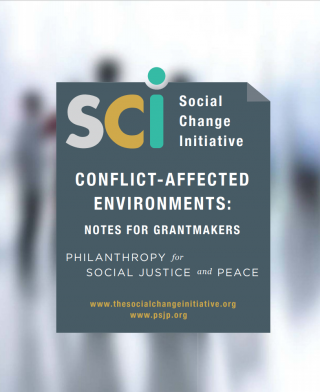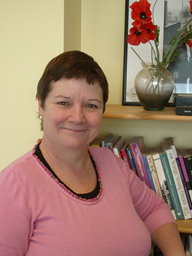Alternatives to War: Philanthropy Making a Difference
6.9 million people were displaced in 2016 due to violence and conflict. They contributed to the estimated 40.3 million who are currently displaced due to war, many of them refugees and migrants. The World Economic Forum queried why, with war costing $ 13.6 trillion in 2015, are we spending so little on peacebuilding? The Global Peace Index noted an improvement in 2016, but pointed out that only 1% is invested in peacebuilding as compared to the economic impact of war. The financial costs are one consideration, however, the human costs of the dead and injured are beyond calculation.
A study released earlier this year by The Social Change Initiative, Funding in Conflict -Affected Environments: Notes for Grantmakers, illuminates how independent philanthropy can tip the scales in support of peacebuilding. The big money may come from governments and multi-lateral agencies, but philanthropy can be nimble and responsive. Practical examples, drawn from interviews with funders and peace activists, highlight funding strategies during the various phases of the cycle of conflict: when tensions are rising, when there is open violence, during a transition from violence, and during conflict transformation. One featured example is the Manusher Jonno Foundation, which was on the ground to support work with the disadvantaged Saontal community in northern Bangladesh in recent years, enabling local people to highlight grievances and mobilize non-violent social justice strategies.
-Affected Environments: Notes for Grantmakers, illuminates how independent philanthropy can tip the scales in support of peacebuilding. The big money may come from governments and multi-lateral agencies, but philanthropy can be nimble and responsive. Practical examples, drawn from interviews with funders and peace activists, highlight funding strategies during the various phases of the cycle of conflict: when tensions are rising, when there is open violence, during a transition from violence, and during conflict transformation. One featured example is the Manusher Jonno Foundation, which was on the ground to support work with the disadvantaged Saontal community in northern Bangladesh in recent years, enabling local people to highlight grievances and mobilize non-violent social justice strategies.
Peacebuilding can be both local, standing in solidarity with a threatened human rights defender by sharing information and opening up broader stakeholder connections, or global, working to mitigate armaments and re-frame international understanding. However, this new study emphasises the potential of local impact. For example, Avina, a foundation in Latin America focused on producing large-scale changes necessary for sustainable development, is collaborating with other funders to support the peace process in rural communities through Redprodepaz, a network for development and peacebuilding in Colombia. Inclusive community development approaches include ex-combatants and political activists which can open up space for dialogue about the nature and dynamics of conflict transformation. Hopes, concerns and aspirations about the potential for peacebuilding are shared alongside practical community initiatives in this ongoing programme of work. Grantmaking by independent philanthropy can be particularly effective at this level, investing in the process of community-based conflict transformation rather than focusing solely on elite decision-making on infrastructure projects.
Funding at the Heart of the Inferno
Independent philanthropy tends to cluster in regions that are emerging from violence. This is welcome, although there is a danger that funders trip over one another in the absence of discussion and coordination. Notes for Grantmakers offers practical examples where independent philanthropy helps to underpin peace processes, but it also highlights interventions to support people during actual conflict, where local people feel isolated and distraught. Inclusive peace agreements are rooted in building local confidence and capacity to advocate alternatives to violence, and to communicate the potential of peaceful change while this violence is still occurring. Philanthropy is well placed to nurture this seed bed of progressive ideas and strategies. There is much evidence to suggest that credibility is built when philanthropists work quietly and support communities during periods of conflict.
The Joseph Rowntree Charitable Trust took that risk in Northern Ireland when it funded work on the early release of political prisoners – a highly controversial issue. As a small society of 1.7 million people, the reality of some 25,000 former political prisoners was a major challenge in terms of re-integration. The Community Foundation for Northern Ireland (CFNI) took up the baton, working with former prisoners from five opposing paramilitary groups to ensure support for the peace process over a twenty year period (1994-2014). The work undertaken was not without political cost as it was often criticised by politicians who adopted a narrower view of peacebuilding. The study also recognizes and explores the sensitivities of philanthropic intervention at such times.
Framing Philanthropy for Peacebuilding
In addition to discussing the importance of funding locally and throughout the various stages of conflict, this new study also considers how independent funding can be most effective if internal foundation decision-making structures and delivery mechanisms are framed to take the specific environment into account. The political uncertainties of conflict-affected environments can bedevil logic models of decision-making, and the flexibility and funding deftness required to exploit pulse points of change can be difficult for some foundations to manage. Small grants, given in a timely and responsive manner, can more effectively deliver sparks of peacebuilding than many top-down programmes. The Neelan Tiruchelvam Trust working in Sri Lanka uses small grants to work with victims and survivors of conflict, while the Tewa Fund supports young people caught up in conflict in Nepal. Examples abound in the work of foundations that are members of the Peace & Security Funders’ Group.
In summary, here are a few key takeaways for funders from this research:
- Invest time in understanding the complexities of violently divided societies and the challenges and opportunities for peacebuilding and conflict transformation.
- Listen to local voices, and particularly those individuals and communities most impacted by the violence.
- Be prepared to invest in programmes of action across all phases of the conflict cycle, not just during the post-conflict stage.
- Ensure that internal structures allow grantmaking that is timely and flexible.
- Think through the added value aspects that an independent funder can bring – connections, voice, developmental support, and information.
In addition, it is important to recognise the element of risk-taking and to encourage board members to embrace it as a key element of independent philanthropy. While accepting that individual funders may be worried about engaging on the frontlines of peacebuilding, a peacebuilding practitioner posed the question: “Are you going to leave people defenceless in the face of conflict or are you going to give them the tools to be able to resist what is happening to them?” When it comes down to it, peacebuilding is a matter of life and death. What greater challenge for independent philanthropy to make a real difference?
Funding in Conflict-Affected Environments: Notes for Grantmakers is available in English, and the Summary Report is available in English, Arabic and Spanish.


